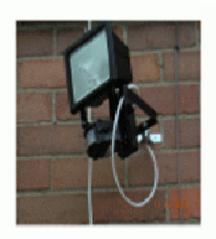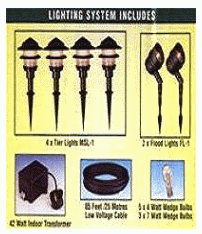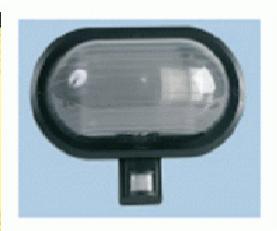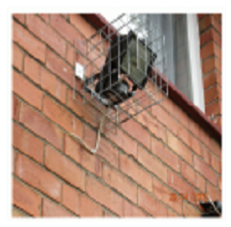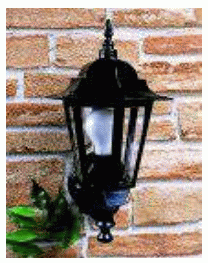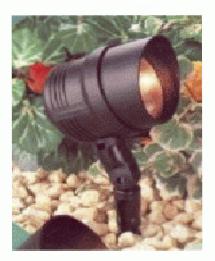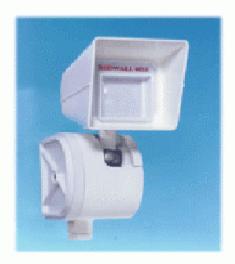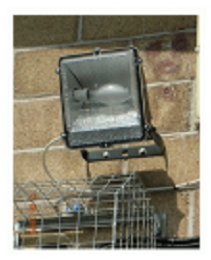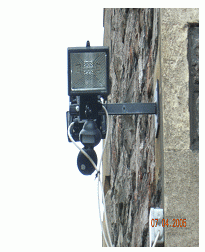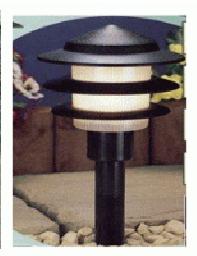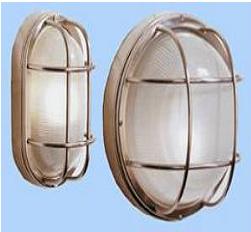LIGHT RANGE
Security
Security lights are available in many forms the most common being a 500w, 300w or 150w in white or black, spotlights usua;y come with a passive infrared movement detector (PIR). The PIR unit also has a photocell device so that the unit can detect light levels (night or day), if the PIR detects movement and the photo cell registers low light, the lamp will be switched on for an adjustable time period.
Most security lights will have a built in mains override facility which is a means of switching the light on and off or on permanently as required, a typical way of doing so would be to use the internal (switched) fused mains spur that should be installed with every lamp. Switching the mains power off and back on within two seconds would put the light on permanently, switching off and back on after ten seconds would put the light on, but back onto PIR detection and timed.
PIR
A light PIR works the same as the above lamp PIR but it is connected to lighting via separate cables allowing the lamp (security or garden lights) to be positioned separately.
Mains Signaling Light
Mains signaling is when a security light PIR (or a mains signal PIR and no lamp) detects movement (day or night) and sends a signal using its 240v mains power supply cable. A plug in bleeper is installed within the property using a conveniently sited mains socket, which when switched on will cause the bleeper to chime every time the PIR detects movement.
Mains Signal PIR
A mains signal PIR will work exactly as the above, but when movement is detected it will operate a built in switch which can be connected to several lights thus switching them on. The PIR could also be used as a simple alarm so that when movement is detected, persons within a building are alerted but no light is activated.
Radio PIR
If 240v mains power is not available, say at the end of a long garden or drive, a radio PIR can be used, the battery powered PIR is installed in a position overlooking the protected are and when movement is detected it send a radio signal to a wall mounted security light on a near by building, the light or lights then switch on for a set period.
Coach Light
Coach lights come in various forms and can be quite decorative, standard colors are white black or brass. A coach light can be switched on and off using a switch or as in most case will have a small built in PIR detector. It is essential that the angle of detection is considered when selecting a coach light with a PIR as many PIR’s are not adjustable and are aimed directly in front of the lamp itself, which may not be the are where movement is likely to be. A coach lantern with a PIR that swivels would be better if the lamp is off set to the detection area.
Coach Light HI:LO
A coach light with a high lo facility works the same as the above standard coach lamp except the lamp is always on at dark. A built in photocell will switch the lamp on as soon as light levels drop, however the brightness of the lamp is adjustable so that a 60w bulb could (and likely would) be set to 20w, this means that at dark the lamp would offer a gentle glow which is usually accepted as quite pleasing on the eye. When the detector detects movement the light switches to full 60w power for a timed period then switched back to 20w (or so) after the on time expires.
A major advantage of a lamp such as a Hi Lo is that in areas of high pedestrian traffic (a busy pavement) the life of the lamp is extended. Switching a cold lamp on and off causes a great deal of ware and tear on the lamp element and reduces the lamp life. Switching from a gentle glow to full power then back again is more gentle on the element and causes less wear.
Garden Lighting (Low voltage)
Garden lighting is usually purchased in kits comprising of sets of lamps such as two 7w 12v spot lamps with adjustable heads and four 4w tier lamps used to light the edges of paths or small shrubs. A kit will usually be supplied with an adequate plug in power supply and a length of flexible two core garden cable which is simply placed on the garden surface. The lamps have a slot which the cable is passed through and then clamped, the clamping forces two spikes into the cable thus picking up 12v power. The lamps can be positioned anywhere on the cable and moved to different positions if required.
Some kits will offer extension cables which is quite critical as the cable is best laid behind shrubs and plants brought out to a lamp and the looped back behind the shrubs and onto the next lamp, this type of cable laying uses more cable then if laid straight from lamp to lamp.
Bulkhead Lamps
Bulkhead lamps come in various forms, with PIR’s and without, bulkhead lamps are probably the most economical lamps to install and usually offer a maximum lamp output of 60w.
WARNING
Electricity kills! Do not attempt to install, repair or modify any mains powered lamps or PIR’s. Always use a competent qualified person who will issue a mains connection certificate confirming a safe connection.
TECHNICAL DATA
There are many different lighting forms, ranging from ultraviolet through to infrared, these are not necessarily all visible to the human eye, as light outside of the 350-750 nanometres range is not visible and is intended only for use in the CCTV industry.
The first category:
- The coiled coil filament bulb is the most known light form and has ratings up to 150W using a bayonet cap or Edison screw ES fitting. It can be of rough service form if vibration or shock may be periodically encountered and although it gives a restricted lighting level, it is of low power consumption and can be used in high-impact bulkhead fittings.
- Tungsten halogen tubes range from 150W through to 1000W and are used in floodlights and projectors. They exhibit an instant brilliant white light without a need for ballast of ignitor circuits but must be mounted at a height sufficient to avoid glare. They can suffer from extended bulb down time.
The second category:
These are all for control by manual switching, timers or photocells and have low running costs, they must not be switched on for short periods as they have ignitor circuits, so are not suitable for use with automatic detectors such as PIR’s or active sensors.
- SOX, low-pressure sodium discharge lighting, is a high-efficiency monochromatic light of yellow/orange form, giving optimum vision at low light levels and used to protect small areas. It is not to be used if colour discrimination is needed because it cannot provide definition. It is extremely economical in use so can be promoted if low running costs are a requirement.
- SON, high-pressure sodium discharge lighting, is the dominant light source for extended period lighting and is used extensively in security and amenity applications. Having an extremely efficient golden white source, it enables colours to be adequately distinguished and has a high luminous efficacy. It has a long life span and a pleasant colour appearance and is becoming increasingly prominent.
- Metal halide gives a soft, clear white light with little glare without the heat generation of tungsten halogen. This is a high-pressure discharge luminaire, usually in the form of a floodlight, and provides excellent colour rendering and a respectful lamp life.
- Mercury fluorescent is used as an alternative to conventional fluorescent lights to give a cool white light. This gives good colour rendering but has a reduced lamp life.
- Compact fluorescent has a small light source to match filament lighting in both colour and quality but is less energy-consuming. There are a huge variety of styles and types available, so it can interchange easily with coiled coil filament lighting.

